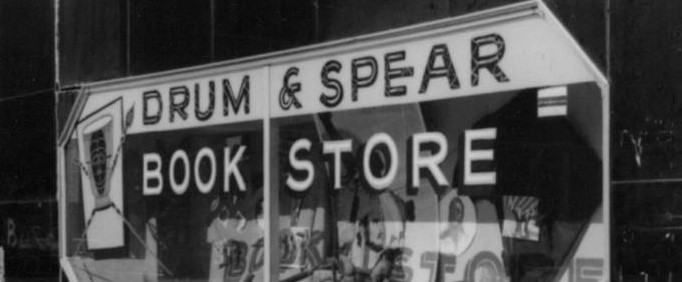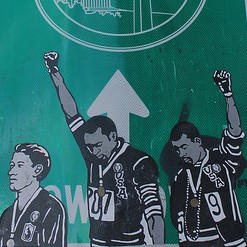
Last month Professor Joshua Clark Daniels excavated a forgotten story from the files of the FBI: the Bureau’s surveillance of black-owned bookstores from 1968 to 1974.
Spying on bookstores might seem quaint in the the age of mass surveillance but there is a connection: how U.S. intelligence agencies see and understand their most vocal and active opponents.
The bookstore surveillance, ordered in 1968 by FBI director J. Edgar Hoover, was part of the Bureau’s Counterintelligence Program. Better known as COINTELPRO, the program sought to infiltrate, disrupt, harass, and destroy radical and leftist organizations.
The targets were selected not because of any suspicion of illegal activity but because of their ideological opposition to the U.S. government policies and their support among the general public.
Clark:
At the height of the Black Power movement, the FBI conducted investigations of such black booksellers as Lewis Michaux and Una Mulzac in New York City, [and] Paul Coates in Baltimore (the father of The Atlantic national correspondent Ta-Nehisi Coates).
One particular target of FBI attention: the Drum and Spear bookstore in Washington DC.
Founded in 1968 by Charlie Cobb, a former secretary for the Student Non-Violent Coordinating Committee (SNCC), the bookstore became a center of the civil rights/black power movement in Washington, DC. Its organizers set out to create a local resource for reliable information about the African American and African world. The store appealed to people of African descent, wherever they lived.
Drum and Spear specialized in books written by black authors and books on Asian, African, and African American subjects. It quickly developed into a combination bookstore, library, community center, and “literary haven,” according to Professor Daphne Muse of Mills College. Muse noted, “It wasn’t uncommon to see Toni Morrison and Amiri Baraka browsing the shelves alongside diplomats and regular folk.”
With such radical agitation taking place a couple of miles from FBI headquarters, J. Edgar Hoover was naturally concerned. The racist FBI director wanted to know everything about such a dangerous place.
The director ordered each Bureau office to “locate and identify black extremist and/or African-type bookstores in its territory and open separate discreet investigations on each to determine if it is extremist in nature.” Each investigation was to “determine the identities of the owners; whether it is a front for any group or foreign interest; whether individuals affiliated with the store engage in extremist activities; the number, type, and source of books and material on sale; the store’s financial condition; its clientele; and whether it is used as a headquarters or meeting place.’
What Has Changed?
More recently, the FBI has targeted so-called “Black Identity Extremists” (BIE), whom it described as “terrorists” and a threat to law enforcement.
In an August 2017 report, the Bureau said:
“The FBI assesses it is very likely Black Identity Extremist (BIE) perceptions of police brutality against African Americans spurred an increase in premeditated, retaliatory lethal violence against law enforcement and will very likely serve as justification for such violence.”
The FBI report said that Micah Johnson, who shot and killed five police officers in Dallas in August 2017 after a Black Lives Matter protest, was “influenced” by “BIE ideology.”
The memo also asserts that “BIE groups” in the 1960s targeted law enforcement officers, as if there was some connection between the Black Liberation Army (a violent group that did not hang out in bookstores) and the organizations like Black Lives Matter that protest police violence today.
There is no connection, not historically, not ideologically. Micah Johnson wasn’t a member or contributor to the Black Lives Matter movement, and Black Lives Matter doesn’t advocate or condone violence against police officers. To the contrary, it advocates that elected officials and law enforcement agencies–not vigilantes–prevent and punish the use of deadly against black people.
The FBI report was circulated to 18,000 law enforcement officers nationwide.
Fabrication
When the American Civil Liberties Union and the Center For Media Justice and others sought more information about the FBI’s treatment of “black identity extremists,” the Bureau refused to turn over any information.
Last month, the ACLU and CM sued for the FBI’s records of “black identity extremists.” They say:
The fabrication of a “Black Identity Extremist” threat is the latest example in a sordid history of efforts to harass, discredit, and disrupt Black activists who dare to use their voices to call out white supremacy. At the turn of the 20th century, law enforcement targeted Ida B. Wells and Marcus Garvey as “race agitators.” The FBI’s Counterintelligence Program (“COINTELPRO”) deployed covert activities against Martin Luther King, Jr., the Student Nonviolent Coordinating Committee, the Black Panther Party, el-Hajj Malik el-Shabazz (previously known as “Malcolm X”), and Ella Baker in the 1950s and 1960s. …. Government crackdowns on Black protest were wrong in the past and have no place in our present.
There is a common denominator between FBI spying on bookstores in the 20th century and FBI spying on “black identity extremists” in the 21st century.
Then as now, the national police perceives criticism–and peaceful protest–of law enforcement practice as a potential threat and a potential locus of law-breaking. So they investigate. Secretly.



